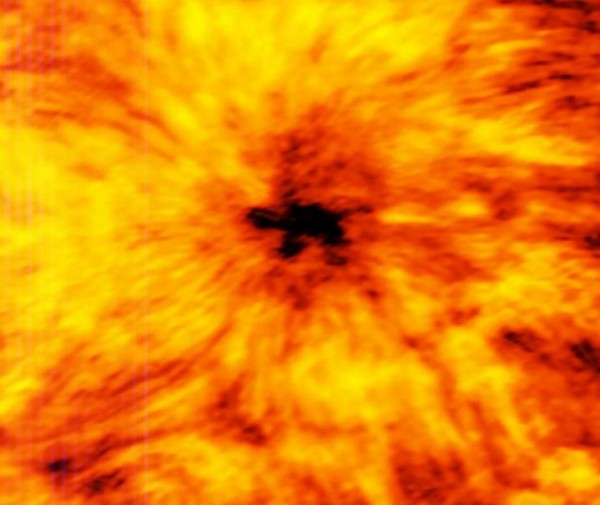ALMA Begins Observations of the Sun in partnership with ESO
| Arthur Dominic Villasanta | | Jan 19, 2017 11:28 PM EST |
(Photo : ALMA (ESO/NAOJ/NRAO)) This ALMA image of an enormous sunspot was taken at a wavelength of 1.25 millimeters.
New images taken with the Atacama Large Millimeter/submillimeter Array (ALMA) radiotelescope in Chile have revealed otherwise invisible details of our Sun, including a new view of the dark, contorted center of a sunspot nearly twice the diameter of the Earth.
The images are the first ever made of the Sun with a facility where the European Southern Observatory (ESO) is a partner. The results are an important expansion of the range of observations that can be used to probe the physics of the Sun. The ALMA antennas were carefully designed so they could image the Sun without being damaged by the intense heat of the focused light.
Like Us on Facebook
ESO is a 16-nation intergovernmental research organization for ground-based astronomy that provides astronomers with state-of-the-art research facilities and access to the southern sky. Its observatories are located in northern Chile.
Astronomers have harnessed ALMA's capabilities to image the millimeter-wavelength light emitted by the Sun's chromosphere -- the region that lies just above the photosphere, which forms the visible surface of the Sun.
The solar campaign team, an international group of astronomers with members from Europe, North America and East Asia, produced the images as a demonstration of ALMA's ability to study solar activity at longer wavelengths of light than are typically available to solar observatories on Earth.
Astronomers have studied the Sun and probed its dynamic surface and energetic atmosphere in many ways through the centuries. But, to achieve a fuller understanding, astronomers need to study it across the entire electromagnetic spectrum, including the millimeter and submillimeter portion that ALMA can observe.
Since the Sun is many billions of times brighter than the faint objects ALMA typically observes, the ALMA antennas were specially designed to allow them to image the Sun in exquisite detail using the technique of radio interferometry -- and avoid damage from the intense heat of the focused sunlight.
The result of this work is a series of images that demonstrate ALMA's unique vision and ability to study our Sun.
The team observed an enormous sunspot at wavelengths of 1.25 millimeters and 3 millimeters using two of ALMA's receiver bands. The images reveal differences in temperature between parts of the Sun's chromosphere.
Understanding the heating and dynamics of the chromosphere are key areas of research that will be addressed in the future using ALMA.
Sunspots are transient features that occur in regions where the Sun's magnetic field is extremely concentrated and powerful. They are lower in temperature than the surrounding regions, which is why they appear relatively dark.
ALMA is the first facility where ESO is a partner that allows astronomers to study the nearest star, our own Sun. All other existing and past ESO facilities need to be protected from the intense solar radiation to avoid damage. The new ALMA capabilities will expand the ESO community to include solar astronomers.
TagsAtacama Large Millimeter/submillimeter Array, ALMA, Sun, European Southern Observatory, ESO
©2015 Chinatopix All rights reserved. Do not reproduce without permission
EDITOR'S PICKS
-

Did the Trump administration just announce plans for a trade war with ‘hostile’ China and Russia?
-

US Senate passes Taiwan travel bill slammed by China
-

As Yan Sihong’s family grieves, here are other Chinese students who went missing abroad. Some have never been found
-

Beijing blasts Western critics who ‘smear China’ with the term sharp power
-

China Envoy Seeks to Defuse Tensions With U.S. as a Trade War Brews
-

Singapore's Deputy PM Provides Bitcoin Vote of Confidence Amid China's Blanket Bans
-

China warns investors over risks in overseas virtual currency trading
-

Chinese government most trustworthy: survey
-

Kashima Antlers On Course For Back-To-Back Titles
MOST POPULAR
LATEST NEWS
Zhou Yongkang: China's Former Security Chief Sentenced to Life in Prison

China's former Chief of the Ministry of Public Security, Zhou Yongkang, has been given a life sentence after he was found guilty of abusing his office, bribery and deliberately ... Full Article
TRENDING STORY

China Pork Prices Expected to Stabilize As The Supplies Recover

Elephone P9000 Smartphone is now on Sale on Amazon India

There's a Big Chance Cliffhangers Won't Still Be Resolved When Grey's Anatomy Season 13 Returns

Supreme Court Ruled on Samsung vs Apple Dispute for Patent Infringement

Microsoft Surface Pro 5 Rumors and Release Date: What is the Latest?














